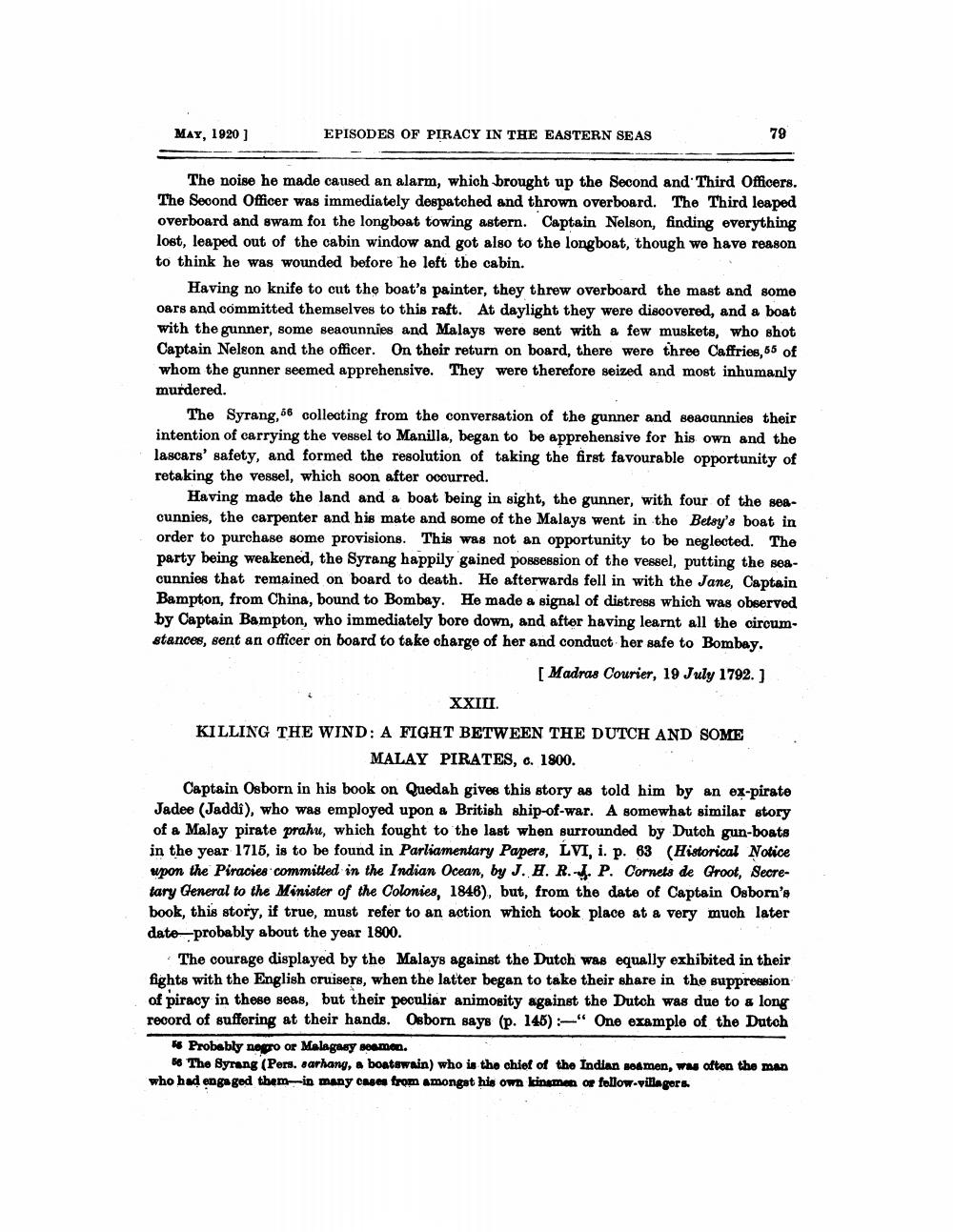________________
MAY, 1920)
EPISODES OF PIRACY IN THE EASTERN SEAS
79
The noise he made caused an alarm, which brought up the Second and Third Officers. The Seoond Officer was immediately despatched and thrown overboard. The Third leaped overboard and swam foi the longboat towing astern. Captain Nelson, finding everything lost, leaped out of the cabin window and got also to the longboat, though we have reason to think he was wounded before he left the cabin.
Having no knife to cut the boat's painter, they threw overboard the mast and some oars and committed themselves to this raft. At daylight they were discovered, and a boat with the gunner, some seaounnies and Malays were sent with a few muskete, who shot Captain Nelson and the officer. On their return on board, there were three Caffries, 65 of whom the gunner seemed apprehensive. They were therefore seized and most inhumanly murdered.
The Syrang, 56 collecting from the conversation of the gunner and seaounnies their intention of carrying the vessel to Manilla, began to be apprehensive for his own and the lascars' safety, and formed the resolution of taking the first favourable opportunity of retaking the vessel, which soon after occurred.
Having made the land and a boat being in sight, the gunner, with four of the seacunnies, the carpenter and his mate and some of the Malays went in the Betsy's boat in order to purchase some provisions. This was not an opportunity to be neglected. The party being weakened, the Syrang happily gained possession of the vessel, putting the seacunnies that remained on board to death. He afterwards fell in with the Jane, Captain Bampton, from China, bound to Bombay. He made a signal of distress which was observed by Captain Bampton, who immediately bore down, and after having learnt all the ciroumstances, sent an officer on board to take charge of her and conduct her safe to Bombay.
[ Madras Courier, 19 July 1792. ]
XXIII. KILLING THE WIND: A FIGHT BETWEEN THE DUTCH AND SOME
MALAY PIRATES, G. 1800. Captain Osborn in his book on Quedah gives this story as told him by an ex-pirate Jadee (Jaddi), who was employed upon a British ship-of-war. A somewhat similar story of a Malay pirate prahu, which fought to the last when surrounded by Dutch gun-boats in the year 1715, is to be found in Parliamentary Papers, LVI, i. p. 63 (Historical Notice upon the Piracies committed in the Indian Ocean, by J. H. R. J. P. Cornets de Groot, Secretary General to the Minister of the Colonies, 1846), but, from the date of Captain Osborn's book, this story, if true, must refer to an action which took place at a very much later date-probably about the year 1800.
The courage displayed by the Malays against the Dutch was equally exhibited in their fights with the English cruisers, when the latter began to take their share in the suppression of piracy in these seas, but their peculiar animosity against the Dutch was due to a long record of suffering at their hands. Osborn says (p. 145) " One example of the Dutch
* Probably nogo or Malagasy soamen.
06 The Byrang (Pers. sarhang, a boatswain) who is the chief of the Indian soamen, was often the man who had engaged them in many cases from amongst his own kinamen or follow-villagers.




